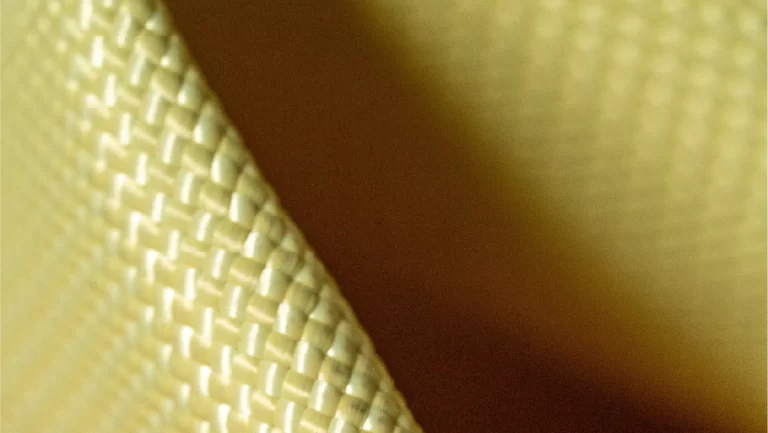In the world of armorthe aramid has become one of the most reliable materials thanks to its combination of strength, lightness, and durabilityHowever, like any material, aramid fabrics are not indestructible: over time and under certain conditions, they can degrade and compromise their performance in critical applications such as armored vehicles, bulletproof vests, fragmentation blankets and other protection systems.
In this blog, we take an in-depth look at the factors that affect the service life of aramid,fabrics, how to identify signs of wear, and the proper storage and handling practices que prolongan su rendimiento.
The importance of aramid in armor
The Aramid fiber is an aromatic polyamide characterized by its high tensile strength, low density, and excellent performance against impacts and extreme temperatures.These properties have made it an essential component in armor at different levels , from civilian and military vehicles to personal protective equipment hasta equipos personales de protección.
However, for aramid to maintain its mechanical and thermal properties throughout its service life, it is essential to understand how it interacts with its environment and what factors can accelerate its degradation.
Factors that affect aramid degradation
Although aramid is resistant, it is not immune to wear. Its degradation depends on various environmental, chemical, and mechanical factors. Below are the main ones:
1. Ultraviolet (UV) radiation
Prolonged exposure to UV rays is one of aramid’s main enemies. Solar radiation gradually degrades polymer chains, causing:
- Loss of color and yellowing.
- Brittleness in fibers.
- Significant reduction in tensile strength..
In outdoor applications, such as visible armor or vests used in open areas, this degradation can occur more quickly if protective coatings or UV-resistant fabrics are not used..
2. Humidity and temperature
The environment also plays a critical role in aramid performance.
- High humidity: While aramid does not absorb large amounts of water, it does retain some moisture that can affect its molecular structure and, over time, reduce its strength.
- Extreme temperatures: Aramid withstands heat, but continuous exposure above 180°C can cause accelerated deterioration. 180°C puede generar deterioro acelerado.
In tropical environments, such as many regions of Latin America, the combination of humidity and heat accelerates degradation if proper storage methods are not used.
3. Chemical exposure
Aramid is sensitive to several chemical compounds that can alter its structure:
- Strong acids and concentrated bases:quickly deteriorate fibers.
- Organic solvents: not all are harmful, but some can damage fabric coatings.
- Oils and greases: can penetrate fabric and compromise strength if not cleaned promptly.
In industries where armor is exposed to chemicals, such as mining or hydrocarbon transport, stricter controls are required.
4. Mechanical stress
The constant usethe friction and repeated loads cause physical wear in aramid fabrics. This includes:
- Deformations.
- Exposed filaments or fuzz.
- Reduction in fabric thickness.
This type of degradation is common in vehicle fragmentation blankets or in vests used daily.
5. Service life
Aramid does not have an infinite lifespan. Depending on exposure and maintenance conditions, its performance may be compromised after 5 to 10 years, even without visible deterioration. This is why armor manufacturers and specialists recommend regular inspections and scheduled replacements.
Best practices to extend aramid’s service life
Extending the service life of aramid fabrics requires not only proper storage but also specific care during use and handling. Here are the most important recommendations:
1. Proper storage
- Store products in a cool, dry, and ventilated place..
- Avoid direct exposure to sunlight and heat sources.
- Use protective packaging to reduce exposure to humidity and dust.
2. Careful handling
- Avoid dragging or scraping fabric against rough surfaces.
- Do not excessively fold aramid blankets or panels.
- Use clean gloves to prevent the transfer of oils or contaminants.
3. Regular cleaning
- Clean with dry or slightly damp cloths..
- Do not use harsh detergents, bleach, or non-recommended solvents.
- If the fabric comes into contact with chemicals, clean immediately with compatible products.
4. Periodic inspections
- Schedule visual inspections at least every six months.
- Look for signs of wear such as discoloration, stiffness, or loss of integrity..
- Perform technical tests periodically to measure material strength.
5. Planned replacement
Even if aramid fabric appears in good condition, armor companies recommend replacing components after their estimated service life. This practice is essential to maintain system safety and reliability.
The impact of poor handling
In the armor industry, there are plenty of examples of how poor handling of aramid fabrics can create risks.
A batch of fragmentation blankets stored in a high-humidity warehouse can lose up to 20% of their strength in less than two years. In another example, a set of vests constantly exposed to sunlight may suffer structural brittleness, compromising their protective capacity during ballistic tests.
These cases highlight the importance of proper storage and handling practices, as the cost of replacement or worse, a failure in armor can be much higher.
Innovations to enhance durability
Research in the field of aramid continues to advance. Today, manufacturers are developing:
- UV-protection coatings that extend the material’s service life.
- Hydrophobic treatments that reduce moisture absorption.
- Hybrid fabricsthat combine aramid with other fibers to increase chemical or thermal resistance.
These innovations allow armor to be increasingly reliable, even under extreme conditions.
The aramid is undoubtedly one of the most important materials in the armor industry. Its strength and versatility have made it a standard for protecting lives and valuable assets. However, its service life depends directly on the environment, handling, and maintenance practices.
Identifying factors that accelerate its degradation, such as UV radiation, humidity, chemicals, and mechanical stress and applying good care practices are key to ensuring these fabrics maintain their properties for as long as possible.
Investing in proper storage, correct handling, and regular inspections not only extends the durability of the fabrics but also ensures that armor fulfills its critical function: providing reliable protection when it is needed most.



